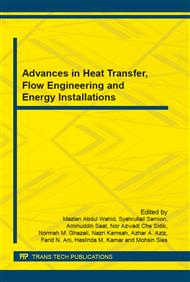[1]
Hunt JCR, Poulton EC, Mumford JC. The effects of wind on people; New criteria based on wind tunnel experiments. Building and Environment. 1976; 11: 15-28.
DOI: 10.1016/0360-1323(76)90015-9
Google Scholar
[2]
Murakami S, Deguchi K. New criteria for wind effects on pedestrians. Journal of Wind Engineering and Industrial Aerodynamics. 1981; 7: 289-309.
DOI: 10.1016/0167-6105(81)90055-6
Google Scholar
[3]
Melbourne WH. Criteria for environmental wind conditions. Journal of Wind Engineering and Industrial Aerodynamics. 1978; 3: 241-9.
DOI: 10.1016/0167-6105(78)90013-2
Google Scholar
[4]
Ohba M, Kobayashi N, Murakami S. Study on the assessment of environmental wind conditions at ground level in a built-up area - based on long-term measurements using portable 3-cup anemometers. Journal of Wind Engineering and Industrial Aerodynamics. 1988; 28: 129-38.
DOI: 10.1016/0167-6105(88)90109-2
Google Scholar
[5]
Ratcliff MA, Peterka JA. Comparison of pedestrian wind acceptability criteria. Journal of Wind Engineering and Industrial Aerodynamics. 1990; 36, Part 2: 791-800.
DOI: 10.1016/0167-6105(90)90076-o
Google Scholar
[6]
Bottema M. A method for optimisation of wind discomfort criteria. Building and Environment. 2000; 35: 1-18.
DOI: 10.1016/s0360-1323(98)00065-1
Google Scholar
[7]
Janssen WD, Blocken B, van Hooff T. Pedestrian wind comfort around buildings: Comparison of wind comfort criteria based on whole-flow field data for a complex case study. Building and Environment. 2013; 59: 547-62.
DOI: 10.1016/j.buildenv.2012.10.012
Google Scholar
[8]
Abd Razak A, Hagishima A, Ikegaya N, Tanimoto J. Analysis of airflow over building arrays for assessment of urban wind environment. Building and Environment. 2013; 59: 56-65.
DOI: 10.1016/j.buildenv.2012.08.007
Google Scholar
[9]
Hang J, Li Y, Sandberg M, Claesson L. Wind conditions and ventilation in high-rise long street models. Building and Environment. 2010; 45: 1353-65.
DOI: 10.1016/j.buildenv.2009.11.019
Google Scholar
[10]
Kubota T, Miura M, Tominaga Y, Mochida A. Wind tunnel tests on the relationship between building density and pedestrian-level wind velocity: Development of guidelines for realizing acceptable wind environment in residential neighborhoods. Building and Environment. 2008; 43: 1699-708.
DOI: 10.1016/j.buildenv.2007.10.015
Google Scholar
[11]
Zhang A, Gao C, Zhang L. Numerical simulation of the wind field around different building arrangements. Journal of Wind Engineering and Industrial Aerodynamics. 2005; 93: 891-904.
DOI: 10.1016/j.jweia.2005.09.001
Google Scholar
[12]
Hu T, Yoshie R. Indices to evaluate ventilation efficiency in newly-built urban area at pedestrian level. Journal of Wind Engineering and Industrial Aerodynamics. 2013; 112: 39-51.
DOI: 10.1016/j.jweia.2012.11.002
Google Scholar
[13]
Ikeda Y, Ikegaya N, Hagishima A, Tanimoto J, Abd Razak A. Characteristics of spatio-temporal fluctuation of urban pedestrian wind derived from Large-Eddy Simulation. 6th International Symposium on Computational Wind Engineering -CWE2014. University of Hamburg, Germany2014.
Google Scholar
[14]
Kato S, Huang H. Ventilation efficiency of void space surrounded by buildings with wind blowing over built-up urban area. Journal of Wind Engineering and Industrial Aerodynamics. 2009; 97: 358-67.
DOI: 10.1016/j.jweia.2009.05.003
Google Scholar
[15]
Asfour OS. Prediction of wind environment in different grouping patterns of housing blocks. Energy and Buildings. 2010; 42: 2061-9.
DOI: 10.1016/j.enbuild.2010.06.015
Google Scholar
[16]
Santiago J, Martilli A, Martín F. CFD simulation of airflow over a regular array of cubes. Part I: Three-dimensional simulation of the flow and validation with wind-tunnel measurements. Boundary-Layer Meteorology. 2007; 122: 609-34.
DOI: 10.1007/s10546-006-9123-z
Google Scholar
[17]
Baskaran A, Kashef A. Investigation of air flow around buildings using computational fluid dynamics techniques. Engineering Structures. 1996; 18: 861-75.
DOI: 10.1016/0141-0296(95)00154-9
Google Scholar
[18]
Hosker Jr R. Empirical estimation of wake cavity size behind block-type structures. Environmental Research Laboratories. 1979: 299.
Google Scholar
[19]
Martinuzzi R, Tropea C. The Flow Around Surface-Mounted, Prismatic Obstacles Placed in a Fully Developed Channel Flow (Data Bank Contribution). Journal of Fluids Engineering. 1993; 115: 85-92.
DOI: 10.1115/1.2910118
Google Scholar
[20]
Oke TR. Street design and urban canopy layer climate. Energy and Buildings. 1988; 11: 103-13.
DOI: 10.1016/0378-7788(88)90026-6
Google Scholar
[21]
Sini J-F, Anquetin S, Mestayer PG. Pollutant dispersion and thermal effects in urban street canyons. Atmospheric Environment. 1996; 30: 2659-77.
DOI: 10.1016/1352-2310(95)00321-5
Google Scholar
[22]
Coceal O, Thomas TG, Castro IP, Belcher SE. Mean Flow and Turbulence Statistics Over Groups of Urban-like Cubical Obstacles. Boundary-Layer Meteorology. 2006; 121: 491-519.
DOI: 10.1007/s10546-006-9076-2
Google Scholar
[23]
Abd Razak A, Hagishima A, Ikegaya N, Mohamad MF, Zaki SA. Mean Wind Flow Field around Idealized Block Arrays with Various Aspect Ratios. Applied Mechanics and Materials. 2013; 393: 767-73.
DOI: 10.4028/www.scientific.net/amm.393.767
Google Scholar
[24]
Hang J, Li Y. Ventilation strategy and air change rates in idealized high-rise compact urban areas. Building and Environment. 2010; 45: 2754-67.
DOI: 10.1016/j.buildenv.2010.06.004
Google Scholar
[25]
Jiang D, Jiang W, Liu H, Sun J. Systematic influence of different building spacing, height and layout on mean wind and turbulent characteristics within and over urban building arrays. Wind & Sturctures. 2008; 11: 275-89.
DOI: 10.12989/was.2008.11.4.275
Google Scholar
[26]
Hunter LJ, Johnson GT, Watson ID. An investigation of three-dimensional characteristics of flow regimes within the urban canyon. Atmospheric Environment. 1992; 26: 425-32.
DOI: 10.1016/0957-1272(92)90049-x
Google Scholar
[27]
Hang J, Li Y, Sandberg M, Buccolieri R, Di Sabatino S. The influence of building height variability on pollutant dispersion and pedestrian ventilation in idealized high-rise urban areas. Building and Environment. 2012; 56: 346-60.
DOI: 10.1016/j.buildenv.2012.03.023
Google Scholar
[28]
Al-Sallal KA, Al-Rais L. Outdoor airflow analysis and potential for passive cooling in the modern urban context of Dubai. Renewable Energy. 2012; 38: 40-9.
DOI: 10.1016/j.renene.2011.06.046
Google Scholar


